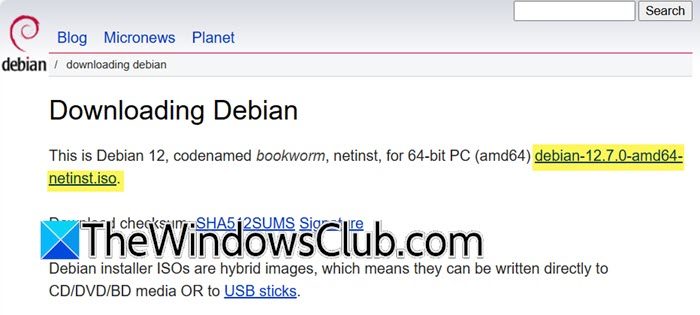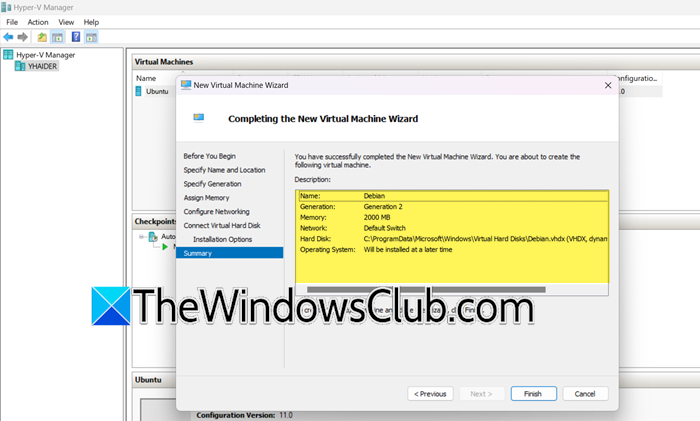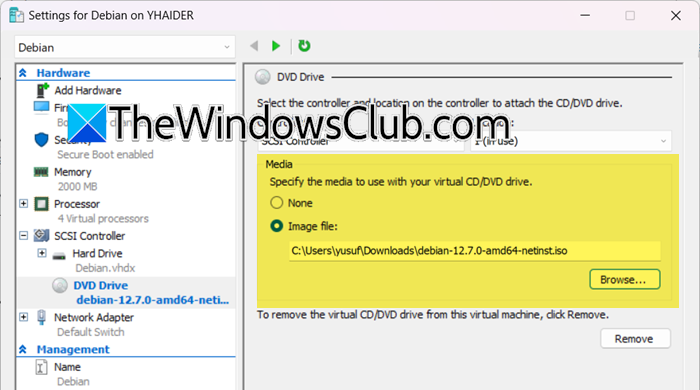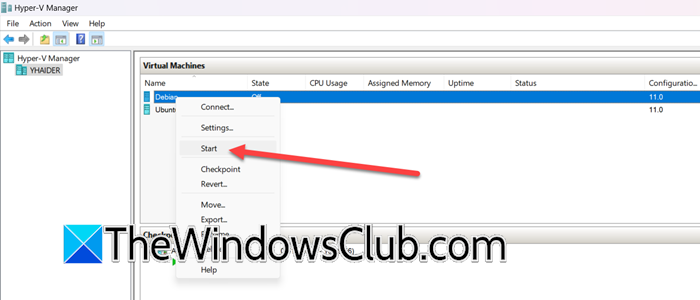Debian is considered to be one of the best Linux Distros. However, to use it, you don’t have to create a separate partition on your disk to install the OS, we can install it as a guest operating system using VirtualBox, VMware Workstation, or Hyper-V. In this post, we will learn how you can install Debian on Hyper-V.
Install Debian on Hyper-V
If you want to install Debian on Hyper-V, follow the steps mentioned below.
- Download Debian’s ISO file on your computer
- Install Hyper-V Manager
- Create a virtual machine
- Configure your virtual machine
- Install Debian on the virtual machine
Let us talk about them in detail.
1] Download Debian’s ISO file on your computer

First of all, we need to download the Debian ISO file on our computer. To do so, navigate to debian.org and click on the hyperlink that says debian-12.7.0-amd64-netinst.iso, this will start downloading Debian’s ISO file. Once you have downloaded the ISO file, move on to the next step.
2] Install Hyper-V Manager

Hyper-V is a built-in Windows program, however, it is not preinstalled. We need to install the Hyper-V feature on our computer and then access the Hyper-V Manager. You can do that by following the steps mentioned below.
- Open the Control Panel by searching it out of the Start Menu.
- Set View by to Large icons.
- Now, navigate to Programs and Features > Turn Windows features on or off.
- Look for Hyper-V, tick it, expand it, and make sure that Hyper-V Management Tools and Hyper-V Platform options are ticked.
- When you click on Ok, you will get a prompt indicating that Windows is trying to install these features.
Once it has been installed, reboot your computer, once it starts, search out “Hyper-V Manager”, from the Start Menu.
Read: How to install Hyper-V on Windows 11 Home?
3] Create a virtual machine

Now that we both have the tools required to make this integration, we can create a virtual machine on which to install the operating system. Some key points to keep in mind when setting up the machine will be discussed hereinafter.
- Launch the Hyper-V Manager by searching it out of the Start Menu.
- Now, go to New > Virtual Machine.
- Click on Next once the prompt appears.
- Now, give the virtual machine a name and click on Next.
- Select Generation 2 (although you can select Generation 1 as well) as it is relatively rich in features.
- Assign your machine a startup memory depending on your system resources, you can also tick Use Dynamic memory for this virtual machine; click Next.
- Now, select a switch that you want to use, you can also create and configure new switches, and them to the mix; click Next.
- Leave the Create a virtual hard disk option selected and click on Next.
- Select Install an operating system later and click on Next.
- Check out the summary and click on Finish.
This will create a virtual machine, however, we need to make some configuration on top of this.
4] Configure your virtual machine

We need to make our virtual machine ready for Debian. So, right-click on the freshly created virtual machine and click on Settings. Now, go to the following tabs and make the required configuration.
- Go to the Memory tab, enable Dynamic Memory, and set the minimum and maximum RAM as per your computer’s specifications.
- In the Processor tab, make sure to allocate at least 2 virtual processors.
- Go to the SCSI Controller tab, and then select DVD Drive, and click on Add.
- Click on DVD Drive, in the Media section, select Image file, and click on Browse. Go to the location where you have stored the image and select it. Click Apply> Ok and then again access the virtual machine’s settings.
- Now, go to Firmware, and change the boot order of the DVD Drive to first by selecting it, and clicking the Move Up button.
- Go to Security, and untick Enable Secure Boot.
- Navigate to Automatic Start and set it to Always start the virtual machine automatically.
- In the Automatic Stop Action, tick Shut down the guest operating system.
Finally, click on Apply > Ok.
5] Install Debian on the virtual machine

After making the aforementioned changes, our virtual machine will be ready for you to install Debian. In order to start the installation process, right-click on the Debian VM and click on Start. Again right-click on the virtual machine and select Connect. Once the VM starts, you need to use the keyboard to make the right selection and follow the on-screen instructions to complete the installation process.
Hopefully, you can resolve the issue using the solutions mentioned in this post.
Read: How to install Fedora on VMware Workstation
Can I run Debian on Hyper-V?
Yes, you can run Debian on Hyper-V, in fact, you can run almost all the Linux Distros on Hyper-V. You can check out the guide mentioned earlier to install Debian on Hyper-V, we also recommend you check our guide to install Kali Linux and Ubuntu on Hyper-V.
Read: How to install Kali Linux on VMWare Workstation
How to install Debian from Microsoft Store?
From the Microsoft Store, you can install Debian for the Windows Subsystem for Linux (WSL). To do so, either go to apps.microsoft.com or open the Microsoft Store, search for “Debian”, and then install it on your computer.
Also Read: Install macOS in Hyper-V on Windows 11.